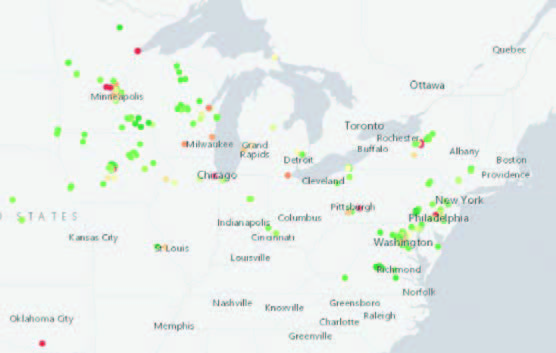2021 will be another interesting year for all, especially in the water-monitoring world. In an era where lockdowns and social distancing are commonplace for the health and safety of everyone, putting your heads together over a 3' by 3' net is no longer an option.
Before the pandemic hit, the League had already expanded our menu of monitoring options especially for individuals. Salt Watch is one example – with a simple test kit, brief instructions and a cell phone, anyone can test for salt pollution in local streams, rivers and ponds.
With in-person trainings shut down, we are able to put more time, stock and supplies into Salt Watch. In the 2019-2020 Salt Watch season, the League distributed just over 1,000 kits. This winter, we are poised to distribute more than 4,000 kits, establish new partnerships and lay the groundwork to expand Salt Watch in more communities.
People will walk across road salt on sidewalks, crunching with every step, all while unaware of how detrimental it can be for water quality.
Our growth in Salt Watch has been a bright spot during the pandemic. We have continued to nurture existing partnerships, including with groups in the Philadelphia area like the Pennypack Ecological Restoration Trust. The Trust even got their own launch webinar in November, in addition to the national kickoff event.
We have also forged new partnerships with groups such as Wisconsin Salt Wise, Minnesota Pollution Control Agency and the Fox-Wolf Watershed Alliance. Also, several schoolteachers are using Salt Watch for student engagement in remote science classes.
As Salt Watch grows, the need for public education becomes more apparent. It is increasingly clear that people will walk across road salt on sidewalks, crunching with every step, all while unaware of how detrimental it can be for water quality.
Even more importantly, people grossly overestimate how much road salt is needed to be effective. This creates an opportunity to explain how public works departments and private contractors can keep drivers just as safe while using much less salt.
Salt Watch is not only providing volunteer-collected chloride data to government agencies for their use, but also informing the public about how road salt can be toxic and how it is already impacting streams (and drinking water) across the U.S.
If you are feeling cooped up this winter, sign up for Salt Watch, test local waters with your free kit and share your results on Water Reporter. Please test multiple times to enhance the data.
After that, we need all our Salt Watch and SOS volunteers to also become teachers. Write letters to the editor (drafts can be found on our Salt Watch website), talk to members of your community or call your homeowners’ association to inform them about how excessive use of road salt harms the environment and threatens public health.
Once we get enough people with the base knowledge and drive to do more, real change can take place for generations to come.
Salt Watch
After you submit a Salt Watch test result, your efforts will not go unnoticed! During the winter season, we comment on results and upload the data to our Salt Watch map every week. Visit the interactive “Salt Watch Findings” map, where you can zoom in on your region to review local salt levels and other results nearby. We have more than 4,000 test kits to distribute this season, so with your help, we hope the map fills up.
Each dot on the map below represents one stream sample. Dark green means a salt level of less than 30 parts per million (ppm), which is ideal for freshwater streams. Yellow represents a high level, more than 100 ppm. Red is more than 230 ppm, which is toxic to aquatic life over a prolonged exposure.
